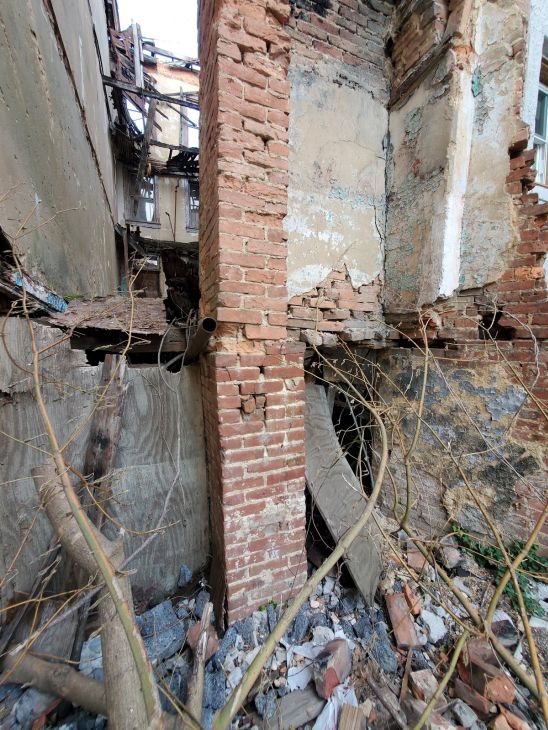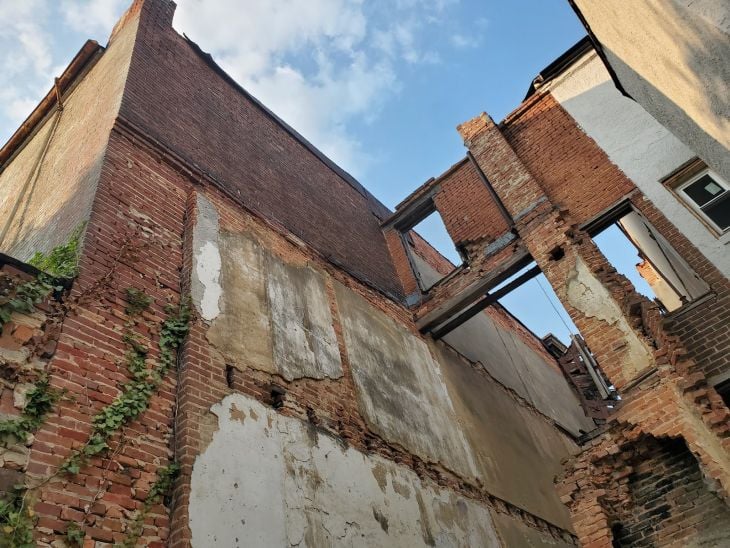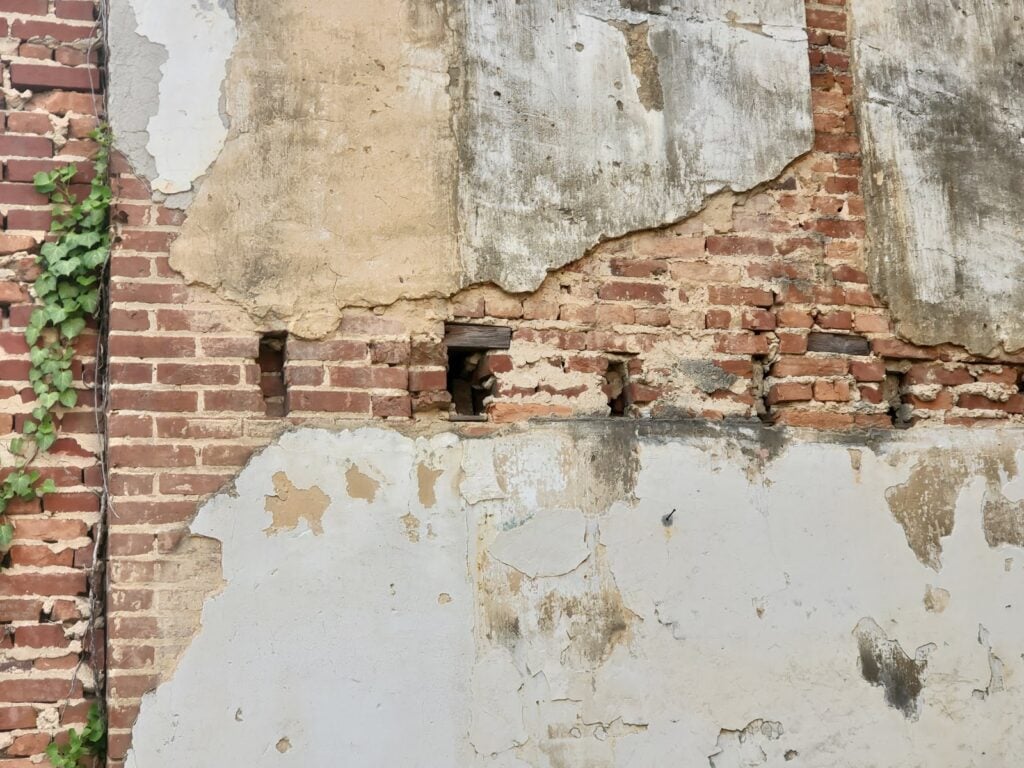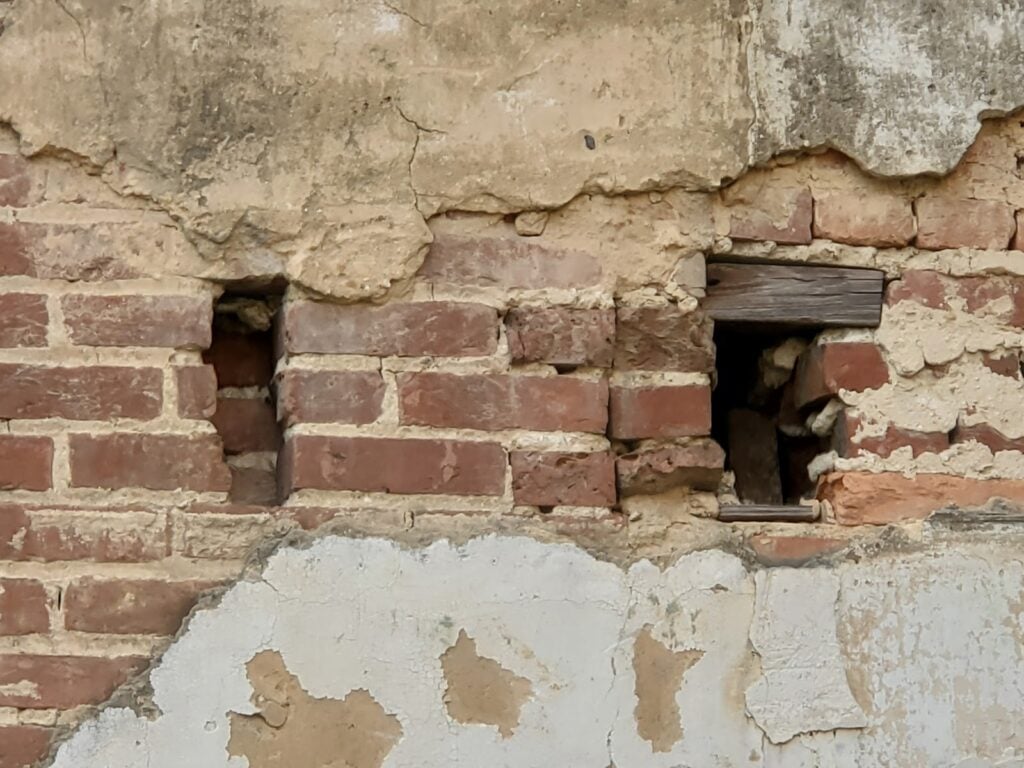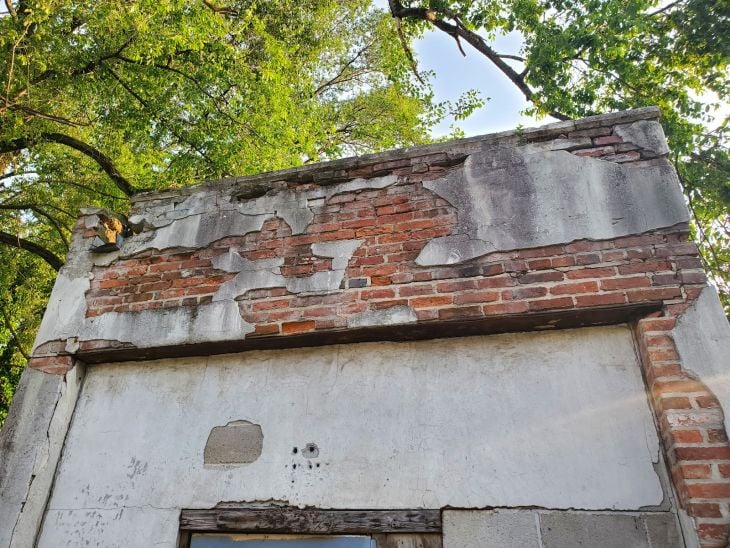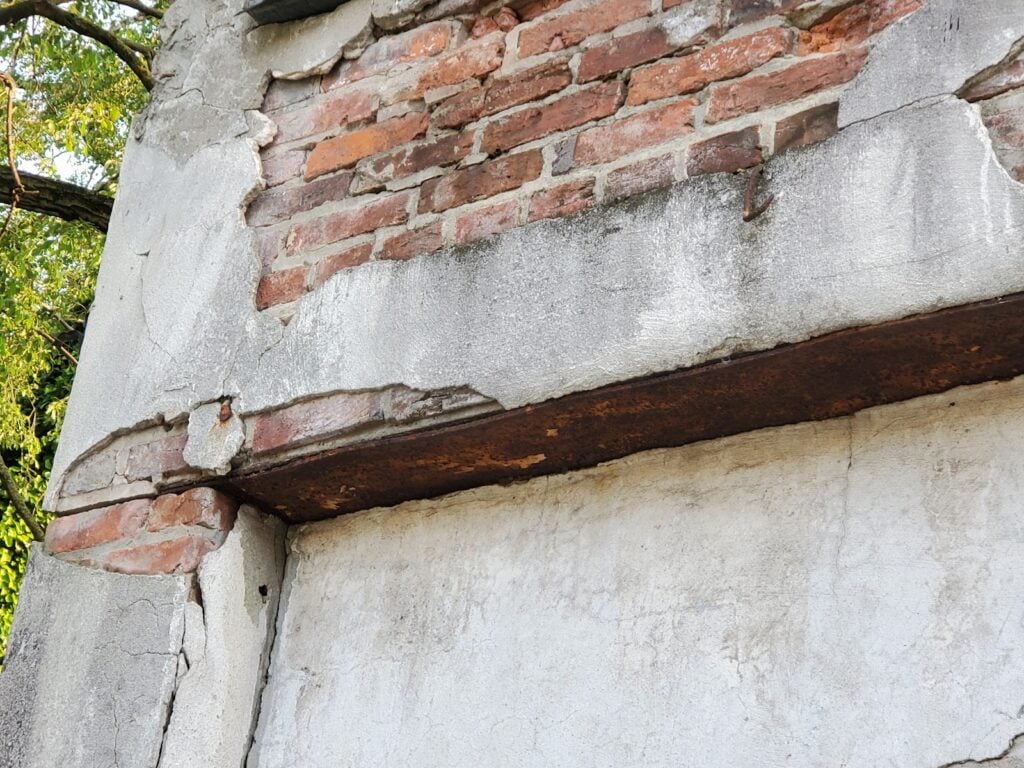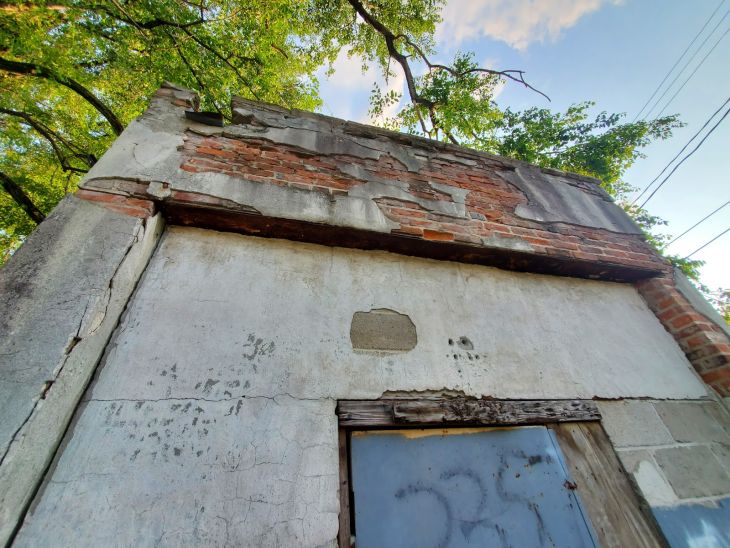Beam pockets on a 100 year old building – case study
Last week, we finished a two-part series in our blog on a particular dilapidated brick rowhome. That building was built over a 100 years ago and has been in disrepair for decades. Part of the building has collapsed and today we’re going to look at a different part of that same building and another nearby building to discuss a separate topic related to spanning structural supports used to create openings in masonry walls. A picture of that building follows for reference.
Structural load path
Buildings are simply very heavy, especially historic row homes in Capitol Hill and other historic neighborhoods of Washington, DC. Each historic row home weighs over 100 tons, even relatively small row homes and large row homes can weigh over 200 tons, just in the dead load of building materials. Imagine, each truck load of building materials weighing over a ton, in net payload, and then imagine hundreds of those truckloads of building materials stacked, one upon the next, into an individual historic brick building. It is easy to imagine the immense mass and weigh of each building. The design of each building works to stand the building structure up in a way that the building is self-supported (with shared demising walls though between rowhomes) from the ground, sometimes several stories into the air.
A load path, runs through the building from the structural footings, embedded into the earth, at the base of the load path, up through the structural walls in the middle, spanning and supporting the floor systems at each level, up to the rooftop and then across the roof. That load path is essentially built up so that there are supporting and dependent elements like a human skeleton, for example, run vertically with horizontal elements bearing on the vertical elements below.
The historic front and rear facade walls are technically structural, in most historic row homes, but in most cases, they are not superimposed by the other elements of the building such as the floor systems and or the roof. In most cases, the side demising walls support the majority of the internal load of the building.
Beam pockets
Beam pockets are omissions intentionally left out of the side demising walls to allow a space for joists and beams to be seated into the brick wall. Essentially, the horizontal floor joists of a building are supporting the live load of the building. The live load includes things like people and furniture and personal possessions. Those things weigh a lot, but the overall load of those items is relatively small compared to the overall load of the building itself. That floor system does not actually connect directly to the footings or the earth, at the upper floors, but through a transfer of the load, at the ends of the beams or joists, the load or wait is imposed upon the side demising walls of the building.
Firecuts
Generally, in historic times, each joist was set into the wall, at spacing around 16 in on center. That means that a two-inch joist would have roughly 14 inches of open space between itself and the next joist on either side. The joist itself would run from one side of the building to the other, and the overall span of the floor system would coincidentally match the open space from wall to wall, but each joist would actually be longer than that open space. The joists sit into the wall space approximately 3 in on each side. This beam pocket essentially creates a resting place for the joist or beam to bear on the brick wall of the building. Where the joists or beams sat in the beam pocket, the joist was generally cut with a slight angle to create a triangular shape at the end of the joist. This angle cut, referred to as a fire cut, did not actually detract from the structural capacity of the joist, but it was important because it allowed the joist to collapse, intentionally, in the case that the joist would be compromised in a fire. The fire cut also allowed for a deeper angled placement into each respective pocket.
This was very important because in a row of buildings, built in succession, if a fire were to cause a floor to collapse, the portion of the floor that would collapse would still have a significant weight. The weight of that floor falling, without an angled fire cut at the end of the joist, could destabilize and lift the bricks up at the upper side of the fire cut. This sort of destabilization could cause a fire In one row home to collapse and topple the wall of the adjoining row home. A fire in one building is a catastrophe, certainly, but if that fire were to cause the collapse of an adjacent building, a brick wall which would otherwise stop a fire, would spread to the adjacent building and the next and the next. These firecuts allowed one building to have floor systems which could collapse but at least would not spread to the next building and all the way down a city block.
In the picture below, the floor system collapsed, likely many years ago. At the height or level of each floor system, you can see a series of vertical shaped rectangles in the side demising wall of the remaining adjacent brick building. These vertical shaped rectangles and succession are the beam pockets where each floor joist used to be nestled and secured.
Joist load and transfer
As explained above, at each floor joist, the live load of the building is supported by the floor system. That live load is imposed upon the floor decking, the wood floor system on top of the joist, and then the joist transfers that load to the brick walls at the side of the building, where each joist sits in a respective beam pocket. that brick wall then carries that load down to the footing of the wall underground.
The next picture below, shows a closer view of the series of beam pockets. The bricks were each set and built around and space filled with the wood beam. In many cases, mortar was squished out from the brick mortar joint onto the side of the wooden beam, but unlike construction today little attention was applied to fill each area to set the joist without the possibility of movement. In fact, as explained above in the details related to the fire cut, it was also a goal of the construction to allow movement of the floor joist. When you look closely, you can see significant variation in the shape and form of each beam pocket.
Historic implications vs. modern methodology
There are significant differences between historic and modern methodologies of building construction, with masonry structures such as the building shown in the pictures above and modern structures varying widely in material types. We’ve already talked about the distinction between historic fire cuts. By modern standards, we would not use a fire cut in the vast majority of circumstances. Concrete is a common building material, in modern times. In structural brick buildings or masonry buildings, in modern times, we would use concrete structural decks, for floor systems, and in many cases we would use wood LVL’s, wood trusses, or steel trusses. In some cases wood or steel trusses would be attached to a building at a steel ledge, similar to a shelf angle, a type of steel angle iron.
In most cases though, in modern times today, many buildings are built with stick framing, especially for residential construction. Residential construction, by comparison to commercial construction, is generally very lightweight and can be assembled very quickly. In modern Construction, wood framing can even be used for multi-unit type construction, with core board or gypsum board fire separation at the demising walls or demising assemblies.
Opening spans
Very similar to spans in the floor systems of buildings, there are also often large spans at the exterior facades of buildings. In the picture below, we show a picture of an area that was once open at an industrial garage door. Unlike many contemporary garage openings this particular building had a carriage style door, not a roll up or rollback type garage door. Nonetheless, the opening overall is wide, over 10 ft in total with and although today it is filled in with a man door and masonry infill, the brick in the wall, above the former opening, was once solely supported by a pair of steel angle irons.
Steel headers
This steel angle assembly worked very similarly to a wooden joist assembly. The structural assembly is supported on both sides, at the end of the joists. In this case, the steel angle is also supported at only the ends, at the time of original construction. The load of weight above the center of the steel angle, similar to the live load on the floor of a historic building, is spread out and supported at the ends with no direct support at the middle of the opening. Essentially that steel angle assembly is transferring the load from the middle, above the opening out to the sides and then the walls at the side of the building carrying that load down to the structural footing at or below the grade of the earth.
The next picture below shows the exterior wall of the building from a lower angle with a slightly wider view of the existing remaining facade. The building is almost in ruins, but in this state of dilapidation we can see several layers of the historic construction, in some cases slightly delaminated away to show the substrates below what is normally seen when the building was in normal condition.
The brick structural walls of the building needed to be tuckpointed or repointed at some point, many decades ago, but instead of proper tuckpointing or repointing and or masonry restoration, a contractor at the time applied a stucco parge coat to the exterior, using the rendering to substitute a proper repointing.
The new wall that is used as an infill is slightly recessed, inside the exterior of the face of the rear wall and the steel angle above the opening is rusted and oxidizing, to the point that it is almost deteriorated and defunct. The infill is a hodgepodge of different materials, likely modified and changed at different points throughout the later part of the life of this old building. At the right side of the wall, a portion of exposed CMU or concrete masonry unit cinder block is exposed. The door has an exposed wood header, likely a 4×4 or 4×6 timber, and a portion of a plywood board at the right side of the door indicates that the door itself has also been changed at some point in the life of this infill portion of the wall. Instead of modifying the opening or purchasing a door that fit the existing opening, the opening size was reduced just enough to fit the newer smaller door.
Historic masonry upkeep and preservation
To properly maintain, repair, and care for these historic buildings, a knowledge, interest and understanding of historic building principles is required. Here in Washington DC, historic masonry buildings are extremely expensive and the amount of financial loss caused by improper repointing and low quality construction is staggering. However, in addition to the direct financial value of the property, there is also a cultural loss when historic buildings are damaged. By comparison, consider neighboring poor cities, when historic buildings are damaged, it’s not just the loss of value to the property owner, there’s also a loss to all inhabitants and visitors of a city, present and future, who care about architecture, history, and culture.
We encourage all of our clients, and all readers of this article and to our blog in general, to prioritize the historic built environment of Washington DC and neighborhoods such as Capitol Hill, Dupont Circle, and Georgetown and become educated on on the difference between proper historic preservation versus improper work which leads to significant damage to the historic fabric of a building.
From a conservation and preservation perspective, several approaches can be taken to improve conditions related to deteriorated historic brick masonry. Primarily, lime mortar brick joints and low temperature fired soft red clay bricks should be inspected and checked on a routine maintenance schedule, either seasonally or at least annually. If brick masonry is kept in good condition, the life of embedded wood elements can be significantly extended. Hire a professional contractor which specializes, understands and appreciates historic construction elements and buildings.
You can learn a lot more on our blog. Feel free to check it out. If you have questions about the historic masonry of your building in Washington DC, contact us or fill out the webform below and drop us a line. We will be in touch if we can help.

